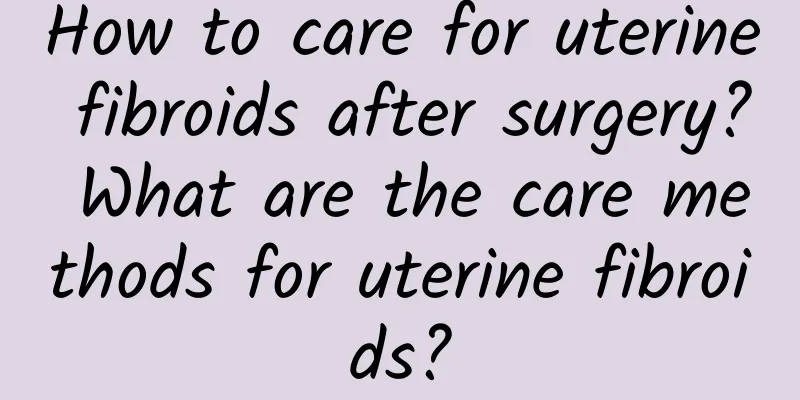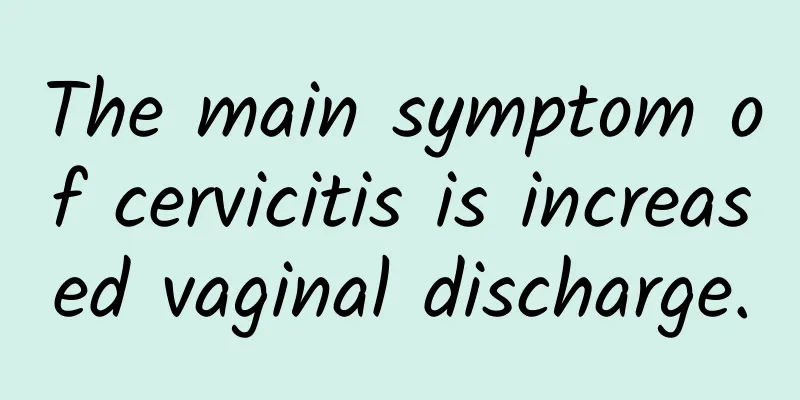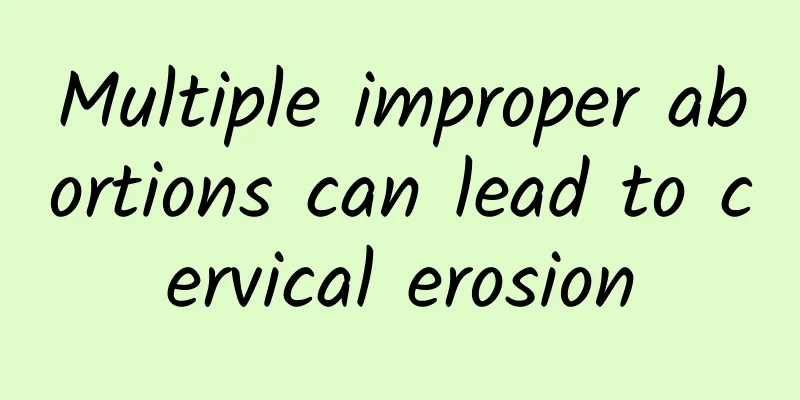How to care for uterine fibroids after surgery? What are the care methods for uterine fibroids?

|
How to care and recuperate after uterine fibroid surgery? 1. Wound care The wound of laparoscopy is usually 1 cm long at the navel and 0 cm long at the lower abdomen. A 5 cm wound, after surgery, a one cm wound is usually or simply sutured, at this time can be sutured with absorbable or non-absorbable sutures, if non-absorbable sutures are used, 7 days after surgery, if absorbable sutures are used, there is no need to remove the sutures; as for the 0.5 cm wound, it can be taped with breathable tape, but sometimes in order to increase the neatness of wound healing, stitches and simple sutures can also be used. For the care of these wounds, before showering or getting wet, care should be taken to keep the wound clean, dry, and other wounds completely healed (about 10 days). Most importantly, since the number of days of hospitalization for laparoscopic patients is very short, patients must pay attention to whether the wound is red, swollen, hot, and painful every day after returning home to prevent infection and inflammation. However, inflammation of the wound after laparoscopic surgery is quite rare. 2. Vaginal bleeding In order to clearly examine the ovaries, fallopian tubes, and the back of the uterus or provide enough space for surgery, a uterine support device is usually placed through the vagina (not necessary for unmarried women) to adjust the position of the uterus, so there will be a small amount of vaginal bleeding after surgery, which is normal, but if the vaginal bleeding exceeds two weeks, please consult a doctor to see if there is any abnormality. As for patients who undergo laparoscopic hysterectomy, since the top of the vagina will be sutured after hysterectomy, brown bleeding within two weeks is still normal. It should be noted that if you walk or carry heavy objects within 8 weeks, it is easy to cause poor wound healing and cause bleeding from the stump, so it should be avoided. 3. Daily life Maintaining a comfortable life and doing a little exercise will help physical recovery. Patients who have undergone laparoscopic fallopian tube surgery and laparoscopic ovarian surgery should resume normal work and rest two weeks after surgery. Patients who have undergone total hysterectomy, except in the early stage of surgery (within two weeks), should avoid riding horses, cycling, sitting for long periods of time, and avoid pelvic congestion and postoperative discomfort. Pay special attention to avoid lifting objects over 5 kg or increasing the burden on the abdomen. After 8 weeks, gradually increase the amount of exercise according to personal physical strength and constitution to reduce the temporary reduction in pelvic support and the discomfort caused in the future. 4. Nutritional intake In principle, the nutritional intake after surgery is the same. We should drink more water to replenish the loss of body fluids during surgery. Usually, you should be able to resume eating after laparoscopic surgery. First, drink some warm water. If there is no discomfort, you can start to enter liquid food (such as porridge), and you can resume normal diet the next day. Since protein is needed for wound healing, you should eat high-protein foods (such as fish, lean meat and eggs)…. ), in order to accelerate wound healing, avoid irritating foods, so as not to stimulate gastric acid secretion and cause gastrointestinal discomfort (such as pepper, smoke, oil, coffee). The biggest difference between laparoscopic surgery and general abdominal surgery is that since the operation requires the injection of carbon dioxide, the abdominal operation is convenient, and there is a tendency to have residual carbon dioxide gas after surgery, so the intake of vegetables and high-fiber fruits should be increased after surgery, and gaseous foods such as sweet potatoes, beans, onions…. Etc. can be avoided, which can reduce the discomfort caused by postoperative abdominal distension. As for larger operations, such as hysterectomy, intestinal mucosal edema, cervical cancer radical resection…, due to the long anesthesia time, long operation time, gastrointestinal absorption of more gas, easy abdominal distension, it is more appropriate to eat after 24 hours. For patients who suffer from postoperative nausea, vomiting, or special physical conditions, there is no need to force themselves to eat. They can eat after the anesthesia has completely subsided. 5. Home treatment (1) Massage The patient lies on his back, and the surgeon stands beside him. Use the thumb to massage the Shenque, Qihai, Guanyuan, Tianshu, Sihai, Guilai, Uterus, Qichong, Xuehai, and Sanyinjiao points, each for 1 minute. After rubbing the palms to warm them up, place them on the lower abdomen and massage the abdomen 36 times in a clockwise direction and 36 times in a counterclockwise direction. Finally, use the back of the palm 10 to 15 times until the pain is felt. Massage once a day, 10 times in a course of treatment. Stop massage during menstruation. (2) Application method ① 15g of Radix Angelicae Dahuricae, 15g of Radix Angelicae Dahuricae, 20g of Radix Tripterygii, 15g of Rhizoma Trigonosciae, 15g of Atractylodes macrocephalae, 20g of Radix Salviae Miltiorrhizae, 15g of Carthamus tinctorius, and 15g of Paeonia lactiflora. Grind them into coarse powder, put them into a cloth bag, steam and iron the lower abdomen, 1-2 times a day, 20-30 minutes each time. Each bag can be used continuously for 5-7 times, 10 days as a course of treatment, and stop using during menstruation. ②1 excrement, 10g of Clematis, dry and grind them separately, mix with appropriate amount of rice wine to prepare the umbilical cord, and apply the plaster. Apply once a day, each time for about 1 hour, and stop using during menstruation. ③ 15g each of Arisaema confusa and white mustard seeds, 12g each of Magnolia officinalis, Pinellia ternata, and orange, 10g each of Angelica dahurica and Artemisia argyi, and 6g of scallion. Grind them into coarse grains, put them into a cloth bag, spray them with water, steam them for half an hour, and iron them under the navel while they are hot, once a day, for 20 minutes each time. Each dose can be used continuously for 5 to 7 days, and 10 times is a course of treatment. ④ 10g of Pinellia ternata and 6g of Scallion White. Mash them together and apply to the navel, cover with Shangshi Plaster, change once a day, one course of treatment for 5 days. (3) Life Tips When uterine fibroids compress surrounding organs, surgical removal should be performed. For women under 40 years old, with heavy bleeding, anemia and other complications, surgical treatment can be considered (only for women who are no longer fertile). People over 45 years old should be treated conservatively, and they are not cured after menopause (bleeding stops). During menstruation, drugs that promote blood circulation and eliminate blood stasis should be used with caution to prevent increased bleeding. The diet should also be based on a light diet, spicy and fried products are prohibited, and proper rest should be taken. Those with heavy bleeding, acute blood loss, dizziness, palpitations, and pale complexion should go to the hospital for treatment to prevent hemorrhagic shock. |
Recommend
What are the symptoms of ectopic pregnancy? Pay close attention
Some of the early symptoms of ectopic pregnancy m...
Explain the main symptoms of vulvar leukoplakia
Vulvar leukoplakia is a gynecological disease tha...
There are many surgical methods for uterine fibroids, such as hysteroscopy and laparoscopy.
There are many surgical methods for uterine fibro...
What factors are the culprits for women suffering from vulvar leukoplakia
Among the many patients with gynecological diseas...
How to properly care for cervical precancerous lesions after surgery
Cervical precancerous lesions are a disease that ...
Is the cure rate for polycystic ovary syndrome high?
Women with polycystic ovary syndrome have a very ...
What should I do if I find uterine fibroids during pregnancy? What measures should I take if I have uterine fibroids during pregnancy?
Make necessary psychological preparations What sh...
What are the common symptoms of cervicitis?
Cervicitis is a disease that troubles many girls....
What to do with menopausal dizziness? There are 2 treatments
When you feel dizzy during menopause, you can imp...
Detailed introduction to the symptoms of vaginitis
Vaginitis is the disease with the highest inciden...
How does Traditional Chinese Medicine explain the causes of threatened abortion?
When a pregnant woman has threatened miscarriage,...
What are the symptoms of bacterial vaginosis
Bacterial vaginosis refers to the imbalance of th...
What to do if you have irregular menstruation after an artificial abortion? If you have irregular menstruation after an artificial abortion, you should refrain from sexual intercourse within one month.
1. Causes of irregular menstruation after artific...
Do women with mild cervical erosion need treatment? Women with mild cervical erosion may not need treatment
Cervical erosion is actually a misunderstanding o...
Women should pay attention to precautions after medical abortion
With the development of society, young people are...









